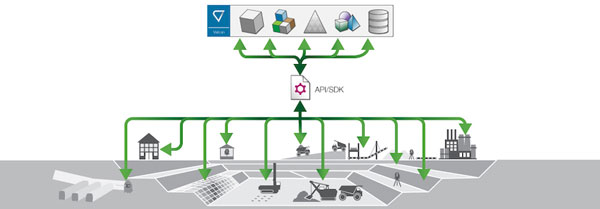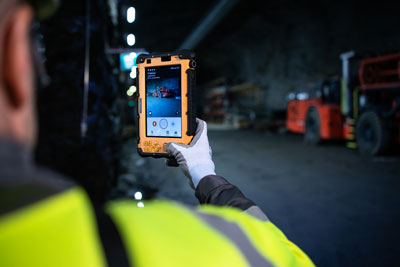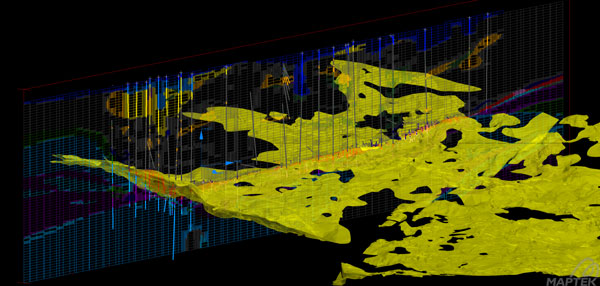Mining Is A Traditionally Hardware-Focused Business. To Achieve The Next Level Of Productivity And Sustainability, However, Data Will Be The Key Asset For Change.
By Jonathan Rowland

It is an undeniable fact that mining is a hardware intensive business. One needs only attend one of the industry’s premier trade shows (when such things are up and running again) to understand the sway that heavy equipment still has over the industry. But when it comes to mining in the 21st Century, could this hardware-centric approach be holding the industry back from taking full advantage of the latest advances in digital technologies? Owning a lot of autonomous iron does not, after all, an autonomous mine make – a point made by Eduardo Coloma, CEO of Australia-based mining software and services provider, Maptek.
“Deploying bigger, faster machines improves productivity – up to a point,” Coloma said. But the key achieving the next level of performance gains is to “use those machines in a smarter way. This means knowing what the machines are capable of and what they are doing at all times, in relation to the product they are handling. It means replacing assumptions about the deposit and the equipment working it with actual knowledge. When miners can apply that knowledge intelligently, through integrated solutions, they can more effectively target their key performance indicators for sustainable mining and shareholder confidence.”
It is a point affirmed by Brett Marsh, director of platform management at U.S.-based Eclipse Mining Technology. While accepting that the automation of equipment was still “the prominent item that people envisage when discussing autonomous operations,” Marsh continued to note that “automation of decisions is equally important, as it represents how humans will interact with advanced technologies, such as artificial intelligence (AI), to optimize decision making.”
“It is important to realise that mining automation goes beyond technology adoption,” added Dominique Verhulst, who heads Nokia’s Energy business in Europe. “Too often, mining automation is approached from and limited to a pit-centric view. But it is fully-fledged business transformation that touches practices, processes, and people across the whole value chain – from exploration to exploitation and transportation.”
Not Bigger But Cleverer
At the heart of this view is the idea that the digital revolution – or Industry 4.0 – is about “smarter thinking,” as Andrew Crose, vice president – autonomous at Hexagon Mining, described it. That is: “reducing the variability within the system to improve throughput and make mines safer, more productive, and more profitable.”
And the case for these technologies has “never been more compelling,” according to Nokia’s Verhulst. “Driven by the need to reinvent operations, increase safety and sustainability, and optimize productivity and efficiency, investments in Industry 4.0 technologies have risen steeply over the past years.”
One of the keys to enabling Industry 4.0 is the availability of data and their use in advanced data-driven technologies, such as AI (see sidebar, Mining and AI: an Example). Indeed, data is fast becoming a singularly valuable weapon in a mining company’s arsenal, as Eclipse’s Marsh explained: “Data are the essential element for improving performance. Whether companies follow the Deming Cycle (Plan-Do-Check-Act), Six Sigma/Lean, or Big Data analytics, the data – clean and validated – are the starting point. It is therefore critical to have a system that incorporates data, creates insights from all mining value chain areas, and uses these insights to minimise value erosion.”
As mining takes place in increasingly remote locations “data become even more valuable,” continued Marsh. “Mining companies that do not embrace data as a valuable asset will quickly fall behind and find it difficult to compete with their better-equipped counterparts.”
“Data collected from a multitude of sensors, both below and above ground, allow miners to optimize operations across mine, pit and conveyor, by gaining near real-time visibility and identifying potential bottlenecks at every step of the process,” agreed Verhulst. In practice, this could mean:
- Leveraging advances in augmented human and machine intelligence to track assets and deploy them on demand, perform predictive maintenance, and deliver just-in-time productivity.
- Using sensors, cameras and drones to develop 360-degree situational awareness of the mine site to make mining safer and more sustainable.
- Augmenting decision making with AI and machine learning, e.g., providing predictive alerts, isolating causes of problems, and suggesting possible courses of action.
But before any such data-driven revolution can take place, data must be collected and verified – which means reliable mine-wide communications networks and robust data management tools.
Collect and Verify
High-performance wireless connectivity in both surface and underground mining areas is “essential to enable digital technologies and applications,” said Verhulst. But this can present a challenge for an industry that “over the past decade has only re-invested a very small fraction of its revenue into innovation.”
Common problems include silo networks and legacy networks that were not created to cater for the demands of ultra-broadband and mission-critical use. “Many mining operations are still reliant on old wireless network technologies, such as Wi-Fi and WiMAX, that were simply not designed for frequently changing environments that need permanent, pervasive, and predictable network coverage. As a result, they do not provide the necessary coverage, reliability, mobility, precision or service prioritization. Similarly, traditional TETRA and P25-based radio networks were not built for broadband data services or video communications.”
Delivering all of these essential capabilities over a single network is “really only possible with today’s 4.9G and tomorrow’s 5G cellular industrial wireless networks,” concluded Verhulst (see sidebar, Private Wireless Networks in the Mining Industry).
Having data is not the same as using data effectively, however; the next key element is to have a platform in place to “build a digital foundation on which the data are integrated and managed, and from which critical insights are generated from data derived from multiple systems,” explained Eclipse’s Marsh. It is this task of data integration and management that was Eclipse Mining Solution’s founding motivation and has led to the development of its OneSource solution.
“Currently, mining professionals spend significant amounts of time collecting, managing and manipulating data, before starting their core activities, be that planning, scheduling or leveraging subject-matter expertise for business improvement initiatives,” continued Marsh. This is not helped by the fact the “each OEM has its own set of sensors and data collection methods for its hardware that may or may not be interoperable with other third-party systems. These differences of data structures and content need to be addressed centrally, via programming and translation, which takes more time and can create a process delay where machine-to-machine communication is required.”
SourceOne is a mining-specific industry platform that tackles these challenges. Different data sources are integrated into the platform, which then harmonizes the data, cleaning, pre-aggregating, and staging it so they are available and prepared for the end user, whether that is a human operator or a more advanced data-driven applications and technologies.
Creating a New Culture
All of this may feel a long-way from the dust and dirt of an operating mine – which is also part of the point. Enabling advanced digital technologies helps remove people from the riskier areas of the mine, improving safety. But it also raises a question of perception, asking how mining culture will need to adapt to a changing world.
“If we accept that digitalization allows organizations to realise the benefits of a continuously-updated single-source of truth, then it is also the path to the democratization of data,” said Maptek’s Coloma. But to achieve this, “the entire company needs to embrace change and adopt the new approach to benefit from the transition to digital systems.” This data culture “embraces systems that are robust, repeatable and user-independent, while meeting the needs of a mobile, shift-based and geographically-dispersed workforce, to reap both safety and economic advantages.”
Coloma uses the example of resource modelling. “There is a huge safety imperative around understanding geological structures. But whether we like it or not, geological interpretation is always subject to personal bias, as is how we interpret new data in relation to existing geological models. The structures do not change; our interpretation of them does.”
Taking a data-driven approach “removes much of the personal geological bias and makes for a consistent process, which drives repeatable and reliable results,” continued Coloma. As an example, Maptek DomainMFC uses machine learning to translate geological data into resource models in much less time that traditional methods, to provide an up-to-date single source of truth for an operation. “Computers handle the data processing and generate multiple scenarios,” explained Coloma, “liberating geologists to do more analysis and higher-level thinking.”
Which points to further benefits of this data-driven approach. It gives time back to the professionals to focus on achieving the best outcomes for the business and can help to close the experience gap between retiring or soon-to-retire professionals and newer entrants into the industry. Data-driven approaches to mining and decision making helps “capture and grow institutional knowledge, mitigating the loss of experience that results when more experienced personnel leave an organization,” noted Marsh.
Ultimately, mining efficiency – once measured by volume of material moved – is now “better achieved by analysing the data in the context of the whole operation and acting on that information,” concluded Coloma.

Managing Change and Other Challenges
Whatever the benefits, changing an industry’s culture is not going to happen without hitting some speed bumps – and the hardest challenges almost always revolve around humans and the suspicions many feel about these new digital technologies.
“This comes in both the offices and the communities,” explained Hexagon’s Crose. “In recent years, we have worked extensively to create workshops and change management to ensure stakeholders are aligned in the offices (e.g., project teams, mining/operations, technology stack suppliers, and equipment OEMS), but also in the community. We have recently achieved a significant success in the Northern Cape, South Africa, partnering with Anglo America Kumba Iron Ore on their autonomous journey.1 This involved making sure the local community was brought along, not left behind – a real risk always inherent in mining.”
The benefits are, however, worth the hard work – not just in terms of productivity and safety. The move to data-driven mining, with its ability to support advanced digital technologies, “impacts the industry’s environmental and social impacts, as mine footprints are reduced and operated more sustainably,” concluded Eclipse’s Marsh. In a world rebuilding from the COVID-19 pandemic and with much pressure to build back more sustainably, this might be the most important advantage of all.
As digital technologies continue to develop – and fall in price – there are fewer excuses for mines not to begin their digital transformation. Putting in place the tools to effectively collect and manage data is the starting point, allowing mining companies to take advantage of the advanced digital technologies available today and being developed for tomorrow.
These developments include the ultimate goal of true autonomy, whereby control of the system is passed to the machines to analyse production objectives and take the necessary actions to meet those objectives. Although we are on the way, true autonomy will require a further technological step change to allow machines to “behave as a human would,” said Marsh. To achieve this, “the processing capability, intelligence and access to data needs to be driven down to the level of individual machines, but the scale of computing power this requires – quantum computing – has only just begun to be developed.”
Note
- The Kumba Iron Ore case study is available at https://connect.hexagonmining.com/casestudy-kumba-autonomous

Private Wireless Networks in the Mining Industry
Private wireless networks can bring new levels of automation and innovation to mines, supporting applications that will enable and empower the next wave of business transformation. With more than 220 private wireless networks deployed worldwide, including at more than 20 mining companies in 50 of their mines, Nokia was one of the first to offer networking services to the mining industry, equipping its first connected digital mine more than eight years ago in Australia. The company has now been selected by four of the top five mining companies to supply their private wireless network solutions.
The Nokia solution portfolio addresses uses and digital applications that go beyond traditional drilling and hauling applications to include person-to-person and group communications, situational awareness, video surveillance, drone inspection, fleet management, predictive asset analytics, and transportation by rail and ship loading in ports. And the company is now building an in-house ecosystem of ruggedized devices, wearables, and applications.
The company has also partnered with global mining industry players, such as Komatsu and Sandvik, to enable their solutions with 4.9G/LTE and 5G networking capabilities. As an example: Komatsu runs more than half of its autonomous haulage production sites in North America, Latin America and Australia on Nokia private 4.9G/LTE networks. The change from Wi-Fi to 4G/LTE reduced communication errors per truck operating hour by 85%, resulting in a production increase of 225,000 tpy.
Mining and AI: an Example
An industry-wide appetite for AI and machine learning applications is being explored through Maptek DomainMCF and its strategic partnership with PETRA to bring digital twin technology to mine planning and scheduling.
Connecting the dots between orebody knowledge and historical data closes the gap between planned and actual conditions, providing the surest way for operations to benchmark operational processes, and devise and implement strategies for continuous improvement. In addition, digital twins allow operations to evaluate future scenarios more confidently for optimising performance.
At every stage, various geological, geochemical or metallurgical factors combine, often in non-intuitive ways, to impact on mining processes. PETRA’s MAXTA digital twin approach consumes the huge resource of historic mine performance data to learn the relationships between these factors and then create simulations and predictions about future performance. These fast, accurate predictions of how the downstream value chain processes will behave for various geologies, covering an entire orebody, are a quantum leap in value. The geological model contains information about how the plant will behave with that particular ore.
Blasthole sample data can now be analysed with geological or geochemical data to develop more accurate and detailed models. This data can be applied in mine planning and scheduling systems, allowing miners to plan for certain objectives and constraints within the mine, as well as across the entire value chain. Drill and blast design can be conducted with consideration for optimal plant throughput and mill energy use. Grade control and stockpile blend planning can be done with an understanding of beneficiation plant recovery performance as a function of variance in the blend.
As more data about the orebody is collected, the MAXTA models can be updated and the schedule refined or adjusted. As business priorities change, future scenarios around plant setpoints and configuration can be evaluated with more confidence. As Maptek CEO Eduardo Coloma concluded, this is “revolutionizing how mines operate. Geologists, planning engineers, and plant operators can work together in a common environment and across a shared understanding of the data.”

